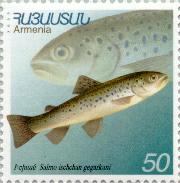Facts About Sevan trout
The Sevan trout, affectionately known as "ishkhan" in Armenian, is a unique fish species found exclusively in Lake Sevan, Armenia. This remarkable fish belongs to the salmonid family and is a relative of the brown trout. Unfortunately, the Sevan trout is currently endangered due to several factors, including the introduction of competing species such as common whitefish, goldfish, and narrow-clawed crayfish during the Soviet era, as well as changes in the lake's water levels.
To preserve this valuable species, several conservation efforts have been initiated. Commercial fishing was banned in 1976, Sevan National Park was established, and breeding programs in hatcheries have been launched.
There are four distinct strains of Sevan trout, each with its own unique breeding time, location, and growth rate: winter bakhtak, summer bakhtak, gegharkuni, and bojak. Of these, the winter bakhtak is the largest, growing up to 90 cm and weighing as much as 15 kg, and it breeds within the lake. Unfortunately, changes in water levels have adversely affected the reproduction of Sevan trout, putting some strains at risk of extinction. Research has shown that the Sevan trout is closely related to the Caspian trout within the brown trout family.

 Turkey
Turkey